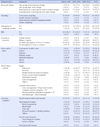Abstract
Purpose
Methods
Results
Conclusion
Figures and Tables
Table 3

A=community health center; B=school; C=industry; D=welfare center; E=medical institution; F=home; G=others; D1=one group pretest-posttest design; D2=one group time series design; D3=nonequivalent control group pretest-posttest design; D4=nonequivalent control group time series design; HRB=health related behavioral domain; PH=physiological domain; PS=psycho-social domain; EV=environmental domain; SP=Single program; CP=Complex program; EDU=education; EXE=exercise; HBRP=health behaviors related program; PSRP=psycho-social related program; AT=alternative therapy; CM=case management; CH=case management+hope intervention; CT=complex exercise program+telephone counseling; PT=physical activity promotion program+telephone coaching; AH=aroma therapy+hand massage.
Table 4

HRB=health related behavioral domain; PH=physiological domain; PS=psycho-social domain; EV=environmental domain; BC=body composition; BL=blood lipid; VS=vital sign; PF/HP=physical function/health problem; P=psychological variables; S=social variables; SP=Single program; CP=Complex program; EDU=education; EXE=exercise; HBRP=health behaviors related program; PSRP=psycho-social related program; AT=alternative therapy; CM=case management; CH=case management+hope intervention; CT=complex exercise program+telephone counseling; PT=physical activity promotion program+telephone coaching; AH=aroma therapy+hand massage.
†Significant research/total research.




 PDF
PDF ePub
ePub Citation
Citation Print
Print




 XML Download
XML Download